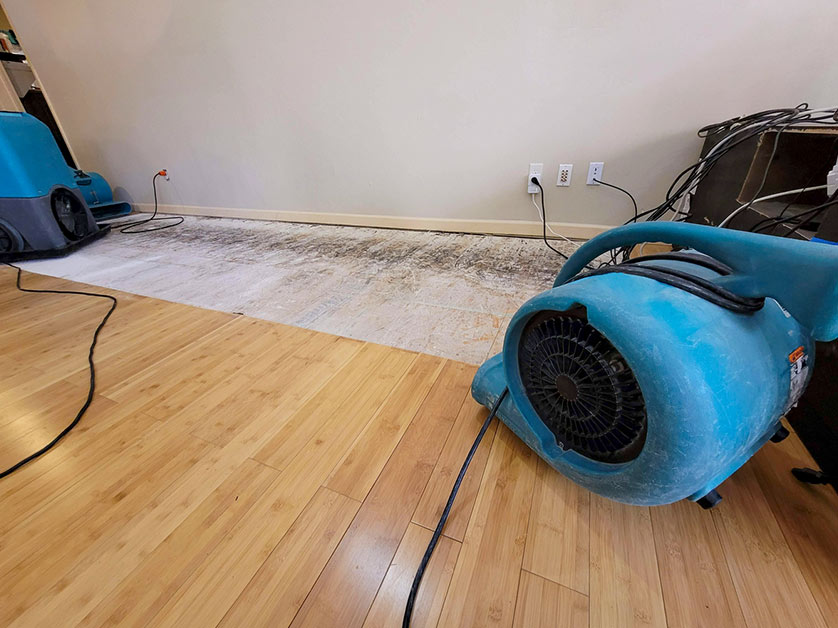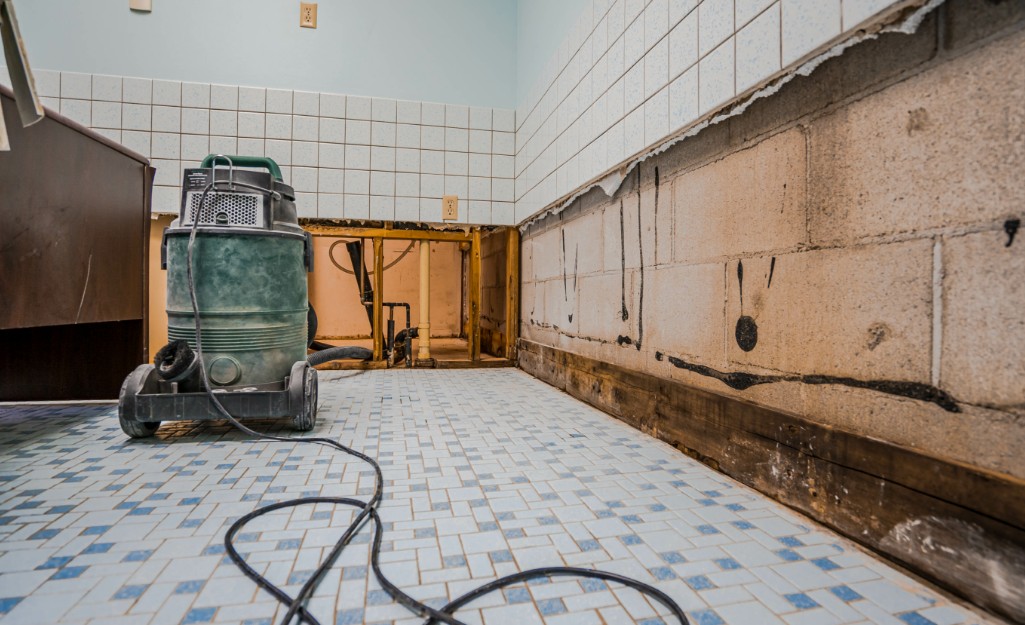What happens when you schedule Flood Cleanup Services
Top Tips for Effective Water Damage Restoration: Protect Your Residential Property Today
Water damage can strike suddenly, creating considerable interruption and possible hazards. Effective restoration calls for an organized technique to decrease more harm. From assessing the damage to implementing safety nets, each action plays an essential function in safeguarding residential or commercial property. Understanding these approaches can make all the distinction in the aftermath of a water-related situation. What important actions should be prioritized to ensure comprehensive security?
Assess the Damage Instantly
When a water damage event takes place, it is vital to assess the damage instantly to alleviate additional issues. This initial assessment helps determine the degree of the damage and identifies affected locations. Water can seep into wall surfaces, floorings, and furniture, leading to mold growth and structural instability if not addressed immediately. A detailed inspection ought to consist of inspecting for discoloration, wetness, and stuffy odors, which show dampness presence. It is also crucial to document the damage with photographs and notes for insurance coverage purposes. Engaging experts for a much more detailed evaluation might be required, particularly when taking care of comprehensive or surprise damage. Flood Cleanup Services. Early recognition and precise evaluation lay the foundation for effective restoration and protect the building from extra difficulties
Shut down the Water
Shutting down the water system is an essential step in avoiding further damage during a water-related event. When a leak or flood occurs, prompt activity is essential to decrease the degree of the damage. Finding the primary water shut-off shutoff must be a top priority. This shutoff is commonly located near the water meter or where the water line enters the residential property. When located, turning the valve clockwise will certainly stop the flow of water. In situations where the primary shutoff is hard to reach, private shut-off shutoffs for devices may also be utilized. Quickly closing off the water system not only secures the building from additional damage however additionally assists in the subsequent restoration procedure, ensuring that recovery initiatives can begin without delay.
Eliminate Excess Water Quickly

Getting rid of excess water quickly is vital for decreasing damage and stopping mold and mildew development in affected locations. The longer water remains in contact with products such as drywall, timber, and insulation, the better the risk of structural damage and the advancement of mold. Water Damage Restoration. Home owners ought to act swiftly to analyze the situation and use appropriate tools, such as damp vacuum cleaners or pumps, to remove standing water effectively. If the quantity of water is significant, getting in touch with expert restoration services might be necessary, as they can supply specific tools and expertise. In addition, removing furnishings and personal belongings from the damaged area can help to minimize damage and assist in the total restoration process. Timely action not just protects residential property yet also help in a smoother recuperation journey
Dry Out the Affected Location
After eliminating excess water, it is important to dry the damaged location extensively. This entails getting rid of any kind of standing water and boosting air blood circulation to facilitate evaporation. Effective drying out will help avoid mold development and more damage.

Remove Standing Water
Swiftly dealing with standing water is critical for effective water damage restoration. The existence of stagnant water can result in further building damage and develop an environment conducive to mold and mildew development. To minimize these threats, it is vital to eliminate standing water as swiftly as feasible. This procedure normally includes utilizing submersible pumps, damp vacuums, or specialized extraction tools. Experts recommend assessing the deepness and level of the water before deciding on the suitable method for elimination. Safety precautions ought to additionally be taken, including putting on protective equipment and guaranteeing electricity is switched off in impacted areas. As soon as the standing water is properly gotten rid of, the drying out process can start, even more safeguarding the residential property from continuous damage.
Increase Air Flow
Boosting air blood circulation is crucial for successfully drying out locations affected by water damage. This procedure assists to expedite dissipation, reducing the danger of mold and mold development. Professionals usually advise utilizing followers to develop a stable air flow throughout the room. Positioning box followers in home windows can reel in fresh air, while high-velocity followers can guide airflow towards moist surface areas. Water Damage Restoration. In addition, opening up doors and windows permits cross-ventilation, improving the drying out process. Dehumidifiers can additionally be employed to remove excess wetness from the air, further helping in drying. By ensuring that air Water Extraction And Drying circulates easily, homeowner can significantly lessen the long-lasting effects of water damage and shield the honesty of their framework
Inspect for Mold Growth
Mold growth is a severe issue adhering to water damage, as it can bring about health problems and structural degeneration. After any type of flooding or leaks, it is important to perform a thorough examination of the impacted locations. This consists of checking hidden spaces such as behind wall surfaces, under rugs, and in cellars or attics where dampness may remain. Indicators of mold include a mildewy odor, discoloration on surfaces, or visible growth. Property proprietors should make use of protective equipment when inspecting, as mold and mildew spores can position wellness dangers. If mold is discovered, it is vital to address it immediately, as delaying remediation can aggravate the problem and raise the risk of significant health concerns for occupants. Early intervention is vital to effective mold and mildew monitoring.

Fixing and Bring Back Damaged Frameworks
When dealing with water damage, it is important to very first examine the structural honesty of the impacted locations. This examination aids determine possible hazards and informs the needed repair service methods. Involving expert restoration solutions guarantees that the restoration process is performed safely and successfully.
Assess Structural Stability First
Before launching any water damage restoration, it is necessary to evaluate the architectural honesty of the damaged area. This assessment aids identify any compromised aspects, such as wall surfaces, light beams, or foundations, which may position security dangers - Water Damage Restoration. Examining for indications of bending, cracking, or mold growth is vital, as these indications can expose underlying damage that calls for immediate attention. In addition, recognizing the extent of the damage can assist restoration efforts and establish whether repairs are possible or if replacement is required. It is essential to record searchings for thoroughly, as this details can be useful for insurance policy claims or future recommendation. Prioritizing architectural assessment assurances that restoration initiatives continue securely and properly, ultimately securing the residential property and its passengers
Use Specialist Restoration Services
Making use of specialist restoration solutions is crucial for efficiently repairing and restoring broken frameworks after water cases. These specialists have the needed training, tools, and experience to assess and reduce water damage extensively. They can determine covert issues, such as mold and mildew growth and architectural weak points, that might not be immediately noticeable. Expert services likewise employ innovative drying out techniques and tools, making sure that all wetness is removed to stop additional damage. Additionally, they abide by industry standards and policies, guaranteeing that the restoration process is secure and effective. By involving restoration experts, residential or commercial property proprietors can expedite recovery, lessen lasting damage, and inevitably shield their investment. This aggressive approach is necessary in maintaining the honesty and security of damaged structures.
Protect Against Future Water Damage
To properly avoid future water damage, home owners should take on a proactive strategy to repair and maintenance. Routine inspection of roofs, downspouts, and rain gutters is crucial; clogged up rain gutters can lead to water overflow and roof leakages. In addition, inspecting for leaks in pipes fixtures and home appliances can ward off prospective damage. House owners must additionally consider installing sump pumps in cellars or low-lying locations to manage water buildup. Securing cracks in foundations and ensuring appropriate drain around the residential property are crucial actions in safeguarding against water breach. Preserving moisture degrees with dehumidifiers can protect against mold and mildew growth. By executing these precautionary actions, homeowners can substantially lower the danger of water damage and protect their building for the long-term.
When a water damage event occurs, it is necessary to assess the damage right away to alleviate more issues (Water Damage Restoration). Removing excess water without delay is important for reducing damage and stopping mold development in influenced locations. Quickly addressing standing water is crucial for reliable water damage restoration. The visibility of stagnant water can lead to additional building damage and create an environment conducive to mold growth. Before starting any kind of water damage restoration, it is vital to evaluate the architectural stability of the damaged location